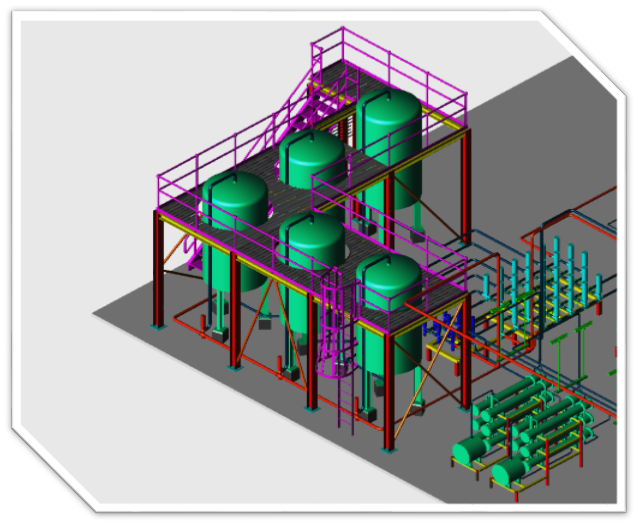PV-ELITE 2020
Pressure Vessel & Heat Exchanger Design & Analysis

TRAINING OBJECTIVES
The Design Center of Heavy Mechanical Complex is now offering the best PV Elite training course in Pakistan from experienced Engineers, with the view to produce skilled workforce to meet the present and future demand of Industry.
PV Elite includes a wealth of localized content to address most any vessel project. Most obvious is its application of the design rules and criteria of the world's major pressure vessel safety codes. And, detailed material and structural steel specification is simplified through database selection.
PV Elite is a complete solution for the quick and comprehensive design of new pressure vessels for the process industry. This program considers the whole vessel, addressing all of the wall thickness rules ad stress analysis requirements for vertical towers, horizontal vessels and heat exchangers.
PV Elite software provides engineers, designers, estimators, fabricators and inspectors around the world with solutions that match their pressure vessel design requirements. Because this program is easy to learn and use, it is perfect for both full time vessel designers and for those occasional users who require quick start up and confidence in their safety code calculations.
PRE-REQUISITE
- Engineering Students (Mechanical)
- Design Engineers
- Mechanical Engineers
WHY PV ELITE?
All of the major codes and standards are included for Vessel & component Design,
- European Norm (EN) 13445 rules for the analysis of unfired pressure vessels.
- ASME BPV Code Section VIII, Divisions 1 & 2 for the design and analysis of vessels and heat exchanger components.
- British Standards PD 5500 guidelines for the analysis of unfired fusion welded pressure vessels, heat exchanger components and tubesheets.
- ASME/ANSI B16.5 and B16.47 standards for pipe flanges and flanged fittings, including equivalent pressure due to applied loads plus pressure ratings for flanges from the DIN standard.
- ASME section UHX, PD 5500 and tubular Exchanger Manufacturers Association (TEMA) standards for designing and analyzing tubesheets and expansion joints in heat exchangers.
- ASME B31.3 rules for replacing area around fabricated tees.
- ASME STS code for stack analysis.
- Welding Research Council (WRC) Bulletins 107, 297, 368 and PD 5500 Annex G rules for calculating local stresses in and around vessel attachments (logs and nozzles).
CODECALC COMPONENT ANALYSIS
For occasions where you want to check individual vessel and/or heat exchanger components, PV Elite's CodeCalc component analysis offers a wide variety of utilities that let you evaluate individual components without the trouble of having to build an entire vessel.
VESSEL ANALYSIS
PV Elite performs all the calculations necessary for the stress analysis of vertical columns, horizontal vessels and heat exchangers
- • Rigorous Structural Load Sets
• Design Evaluate and Re-rate Modes
• Wall Thickness for Pressure
• Wall Thickness for Total Load
• Fitness for Service Assessment
OUR FACILITIES
- Fully equipped Computer lab
- Flexible and comfortable furniture
- Parking
- Secure environment
EXCEPTIONAL PACKAGES
Our training Participant’s package includes:
- Training material in a folder
- Soft copy of training material
- Group photograph
- Training certificate
- Comfortable spacious training venue
TRAINING CURRICULUM
Basics of Pressure Vessel
- What is Pressure Vessel & its Types?
- Different components of a Pressure Vessel
- Dish Ends
- Nozzles
- Flanges & its Faces
- Vessel Supports
- Code used for Pressure Vessel
- ASME Code & its different Sections
- Material of Construction (Code References. . . .)
- For Pressure Parts
- For Non-Pressure Parts etc.
What is PV Elite 2020?
- Interface of PV Elite Program
- Element Basic Data Area
- Element Additional Data
- 2D model view
- 3D model view
- Orphic Control.
- Tool bar
- Main menu
- Starting the Test Model,
- Selection of Design Code
- Setting of Units
- Sequence of placement of elements
- Viewing Element Data
- Viewing Elements and Node Numbers
- How to Build a Horizontal Vessel
- Nozzles
- Designating Orientation and Location
- Nozzle Types
- Adding Nozzles
- Input Options
- Adding a Hillside Nozzle
- Adding Radial and Hillside Nozzles in the Top Head
- Nozzle Code Compliance
- UG-37 and Appendix 1-10
- Adding Nozzle Reinforcement to the Model using UG-37
- Adding Nozzle Reinforcement to the Model using Appendix 1-10
- Large Nozzles in Cylindrical Shells
- Using UG-45 for Large Nozzles
- Heads
- Hemispherical Heads
- Elliptical Heads
- Tori-spherical Heads
- Flat Heads
- Designing for Vacuum
- Cone to Shell Junctions
- Inserting Components
- Understanding Joint Efficiency
- Joint Efficiency and Welds using UW-12
- Radiography and Weld Categories
- Modifying Joint Efficiency
- Setting Wind Loads
- Vessel Supports
- Vessel Supports, Forces on Vessel Skirts
- Designing and Analyzing a Skirt
- Viewing a Plot of the Base Ring and Analyzing Further
- Vessel Saddle Supports
- Saddle Design and Analysis
- Vessel Leg Supports
- Designing and Analyzing Vessel Leg Supports
- Lug Supports on Vessels
- Designing and Analyzing Lugs on Vessels
- Running the Analysis
- Viewing Internal Pressure Calculations
Note:
Following to be arranged by participant at home for better learning
- A Laptop or Computer
- PV Elite Software for your Practice
- Basic mathematics and Engineering Knowledge
- Basic Drawing knowledge
TRAINING STRUCTURE
- Number of Classes 03
- Duration of each class 3 hr.
(Monday, Wednesday & Thursday)
Total duration 18 Hrs.
- Training Methodology 100 % practical
- Medium of Training English and Urdu
- Training venue DESIGN CENTER COMPUTER LAB
- Fee Rs. 10,000
- Mode of payment Cash
- Certificate Students will receive certificate,
Confirming attendance and training
Completion.

